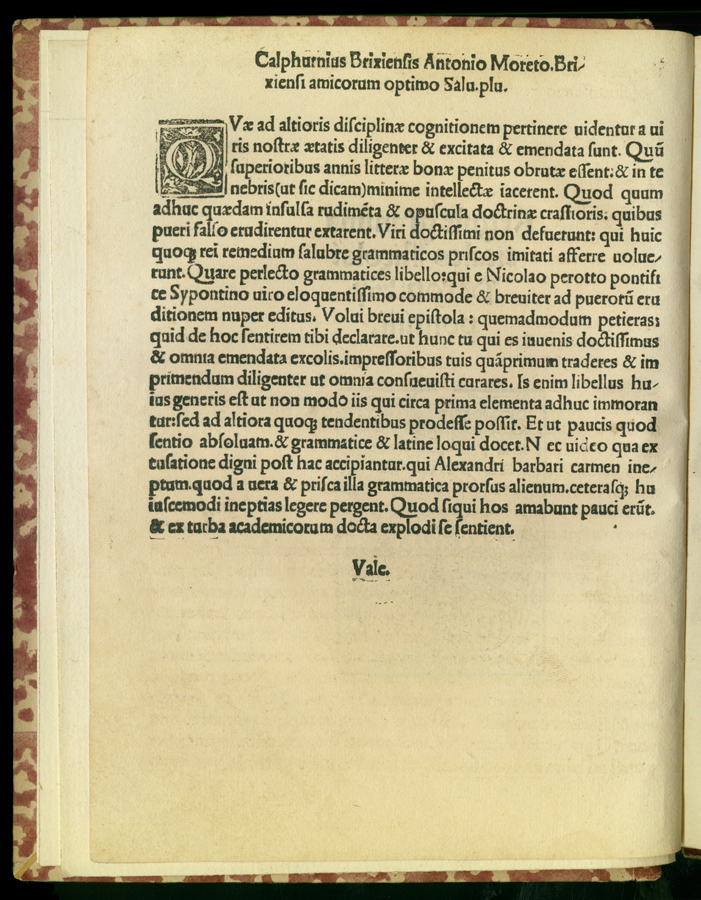2.10 Advertising an Old Standby
Toward the middle of the sixteenth century Perotti's grammar ceased to be published frequently in Italy, but it did have a number of late-century editions, each one it seems with more fulsome advertising than the last. The Giunta at Florence, almost as if to make amends for the awful edition of 1543, gave the book a handsome, simple quarto edition in 1560. An abbreviated text in handy octavo came out in Venice in 1561, 1568, and 1579 "liberated from innumerable errors by Borgaruccio Borgarucci." (60) The claim that the many earlier printings were badly inaccurate became a refrain in late-century editions, but it is hard to say exactly what it meant in marketing terms. It may be that the many Perottis printed early in the sixteenth century had acquired so bad a reputation for the quality of their text that this fact had contributed to the book's ceasing to be published regularly, with the further result that printers had to claim to have edited the text anew to recapture a market for it. (61)
On the other hand, for some of these later editions we can infer other considerations than the reputation of the book. For example, it seems likely that Giorgio Marescotti's 1582 edition was part of his (ultimately unsuccessful) campaign to become official printer to the Grand Dukes of Tuscany. He gave Perotti's grammar a new preface that seems more than a little defensive about the whole project. Marescotti first reminded his readers of Perotti's century-long reputation. He then backtracked a bit, saying that, however old-fashioned, the book was still likely to be useful to the youths of Florence. He was claiming to be a servant of the Florentine state by printing a classic of humanist scholarship and pedagogy. He also claimed that he had decided to base his text not on any recent edition but on early ones, implying that he used an edition or manuscript close to the author's own text. (62) Although Perotti's grammar was not much reprinted in Italy after 1560, we know that it was still on the market much later and in use in some schools well into the seventeenth century. (63)

Advertising was part of the success of Perotti's Rudimenta from the start, and it tells us clearly what grammar masters valued in the work. Perotti himself provided no introduction to his text, but such humanist modesty was a liability in the competitive market for textbooks. Printers and editors almost immediately added prefaces composed with marketing needs in mind. Brief but otherwise typical is that of Giovanni Calfurnio (1433-1503) which appeared in Venetian editions from 1478 onward and with increasing frequency toward the end of the century. Calfurnio praised Perotti in general terms as one of those modern scholars who revived the beautiful Latin of ancient times, and specifically for having composed a grammar that would substitute for "certain foolish primers and over-dense grammars with which boys were taught falsely." (64) Over-density is an interesting charge, since the Rudimenta is also chock full of things to memorize. Calfurnio probably meant that Perotti's work is relatively more concerned with vocabulary and less with multiplying rules than it predecessors. Calfurnio went on to name the Doctrinale among the worthless textbooks: "Nor do I see what possible excuse those who employ the silly poem of barbarous Alexander can henceforth give." (65)
NOTES
- Open Bibliography
- (60) Borgarucci would go on to a significant career in Venice as an editor of classical texts, see DBI 12:567.
- (61) This may be the import of an application for a new privilege to print Perotti "in meliore forma" presented to the Venetian Senate in 1526; see Fulin 1882a, 206. The earliest reference I have found to correcting large numbers of earlier printers' errors is Bartolomeo Mascara's claim in Perotti 1539.
- (62) Perotti 1582: ad veterum codicum fidem totum negotium confectum est.
- (63) Two copies appear in the inventory of the Antoni shop at Milan cited by Stevens 1992, 411-412, for which information I am indebted to Professor Stevens. A surviving copy of Perotti 1560 at Ravenna has ownership marks of students dated 1634 and 1648; Deutscher 2002, 1014 reports a single copy in use at Novara in the same period.
- (64) ...quaedam insulsa rudimenta & opuscula doctrinae crassioris, quibus pueri falso erudirentur.
- (65) Perotti 1501, 1v: Nec video qua excusatione digni post hac accipiantur qui Alexandri barbari carmen ineptum. See also Worstbrock 2001, 62-63.